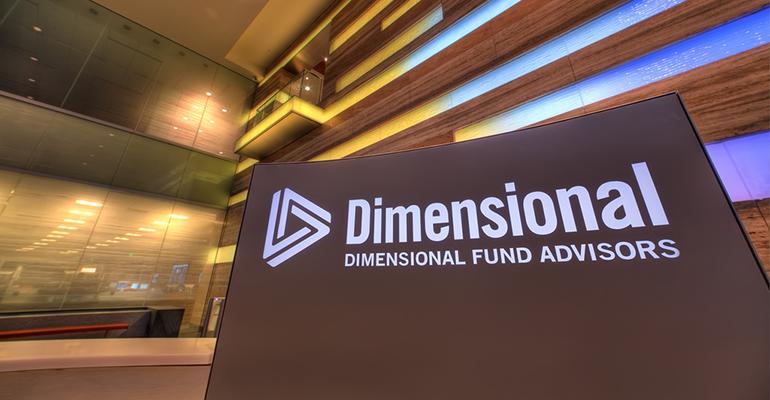(Bloomberg) -- For decades, Dimensional Fund Advisors was famous on Wall Street for its exclusive admission policy: Only a hand-selected network of financial advisors enjoyed access to their systematic mutual funds.
All that changed drastically three years ago when the quant giant capitulated to the exchange-traded fund revolution.
Now the Austin-based firm’s pivot — a milestone for the ETF community — is paying off. Its lineup of nearly 40 ETFs has amassed over $100 billion thanks to inflows and fund conversions, making it among the top 10 largest US issuers in the $7.3 trillion industry.
At the same time, its mutual-fund business has shed roughly $74 billion in flows since its ETF debut as clients migrate to the low-cost and tax-efficient investment strategies, Bloomberg Intelligence data show.
Dimensional’s ETF embrace — far from painless as fees everywhere hit rock-bottom levels — underscores the existential challenges that asset managers are grappling with across the industry.
Gerard O'Reilly, co-chief executive officer and chief investment officer of Dimensional Fund Advisors, speaks during the Exchange ETF Conference in Miami Beach, Florida, U.S., on Wednesday, April 13, 2022. The Exchange is an annual gathering for ETF-centric advisors and the ETF industry. Photographer: Eva Marie Uzcategui/Bloomberg
“Before we had ETFs available, it was, ‘we like your investment proposition, we appreciate your support model, but we typically only use ETFs,’” said Gerard O’Reilly, Dimensional’s co-CEO and chief investment officer, in a phone interview. “We definitely have a bigger client footprint than we did pre-ETF.”
ETFs have taken in more money than mutual funds, excluding money-market funds, for 11 consecutive years, with the latter on track for a sixth straight year of outflows, Investment Company Institute data compiled by Bloomberg show. This year, investors have pulled nearly $473 billion from mutual funds while their exchange-traded brethren have attracted more than $351 billion.
That one-way travel has driven industry heavyweights to build out ETF businesses over the past decade. Capital Group and Morgan Stanley were among the last holdouts, before both launched their own products in recent years.
“ETFs are the opposite of exclusive but that’s where all the fish are biting,” said Bloomberg Intelligence senior ETF analyst Eric Balchunas. “Every big legacy asset manager is going to have to go through this painful but necessary transition, so better now than never.”
At the same time a seemingly endless race-to-the-bottom has sparked a collapse in expense ratios as issuers fight for market share. While it’s good news for end-investors, it’s a painful setup for asset managers’ margins.
Odd Lots: Dimensional’s O’Reilly on Future of Fund Management
The solution for firms is to simply try and grow their funds as large as possible, according to Peltoma Capital Partners founder and chief investment officer Rubin Miller. Take BlackRock Inc. and Vanguard Group, the two largest ETF issuers. They charge an average of 30 basis points and 9 basis points, respectively, across their US lineups, with nearly $4.5 trillion of assets between them. Their funds subsequently generate billions of dollars from fees each year.
“You’re going to charge your expense ratios on a higher asset base, but you’ve got to get really big to lower expense ratios and you need pretty accommodating markets,” said Miller, who worked at Dimensional before founding his advisory business. “The hope is that markets go up and you keep reducing your fees, and maybe make more profits.”
Dimensional has been forced to accept that low-cost reality. Their stable of actively managed ETFs, which typically command higher fees than passive products, charge less than 25 basis points on average, Bloomberg data show. Shortly before their debut, Dimensional slashed expense ratios on nearly a third of its mutual funds to bring them in line with the planned ETFs.
Additionally, Dimensional’s mutual funds — which, along with separately managed accounts, represent the bulk of the firm’s more than $600 billion in assets — are priced at the institutional-share class level, which typically carry the lowest costs among share classes for the structure, according to O’Reilly.
“We wanted to make it straightforward for financial professionals to choose which wrappers work better for them and not have fees be the driver of that decision,” O’Reilly said.
All the same, the gravitational pull of ETFs is proving hard to resist for investors of all stripes. While mutual funds have the power of incumbency in the US retirement system and 401(k)s, generational shifts are set to benefit ETFs in the years ahead.
An annual survey by Schwab Asset Management released last month found that among 2,200 investors, 89% of millennials say ETFs are their investment vehicle of choice compared to 78% of Generation X and 67% of baby boomers. Ease of trading, followed by low costs and tax efficiency, were the top cited reasons.
“If you think about where are the net inflows coming into asset management and ETFs, it tends to be younger people,” said Deborah Fuhr, co-founder of ETFGI. “And when you think about the transfer of wealth, I think they’ll continue to look at ETFs.”





